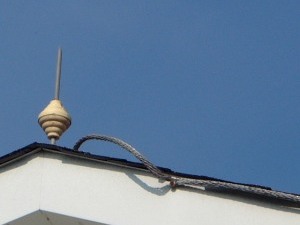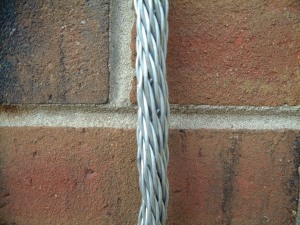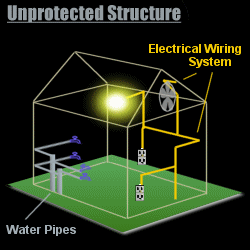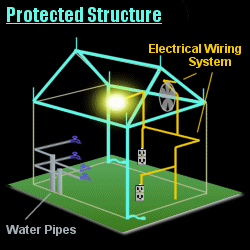How lightning protection systems work
 
|
In September of 2025, my work is generating the most income it ever has in my career. Yet, I'm being forced to shut down my successul operation, against my will, due to one cause alone: 95% of that revenue is being stolen by piracy and copyright infringement. I've lost more than $1 million to copyright infringement in the last 15 years, and it's finally brought an end to my professional storm chasing operation. Do not be misled by the lies of infringers, anti-copyright activists and organized piracy cartels. This page is a detailed, evidenced account of my battle I had to undertake to just barely stay in business, and eventually could not overcome. It's a problem faced by all of my colleagues and most other creators in the field. |
Lightning protection systems are the modern development of the innovation pioneered by Benjamin Franklin: the lightning rod. Today, lightning protection systems are in use on thousands of buildings, homes, factories, towers, and even the Space Shuttle's launch pad. This article will examine why lightning protection is necessary and what the systems can and cannot do.
 In This Article: In This Article:
- Components of a lightning protection system
- Lightning protection systems - What they do and don't do
- How a lightning protection system works
- Lightning and Surge Protectors / UPS Devices
- Lightning dissipation / elimination myths
- Lightning protection facts
Components of a lightning protection system
Lightning rods or 'air terminals' are only a small part of a complete lightning protection system. In fact, the rods may play the least important role in a system installation. A lightning protection system is composed of three main components:
- Rods or 'Air Terminals' - The small, vertical protrusions designed to act as the 'terminal' for a lightning discharge. Rods can be found in different shapes, sizes and designs. Most are topped with a tall, pointed needle or a smooth, polished sphere. The funtionality of different types of lightning rods, and even the neccessity of rods altogether, are subjects of many scientific debates.
 - Conductor Cables - Heavy cables (right) that carry lightning current from the rods to the ground. Cables are run along the tops and around the edges of roofs, then down one or more corners of a building to the ground rod(s).
- Ground Rods - Long, thick, heavy rods buried deep into the earth around a protected structure. The conductor cables are connected to these rods to complete a safe path for a lightning flash around a structure.
The conductor cables and ground rods are the most important components of a lightning protection system, accomplishing the main objective of diverting lightning current safely past a structure. The 'lightning rods' themselves, that is, the pointy vertically-oriented terminals along the edges of roofs, do not play much of a role in the functionality of the system. A full protection setup, given good cable coverage and good grounding, would still work sufficiently without the air terminals.
Lightning protection systems - What they do and don't do
A lightning protection system's only purpose is to ensure safety to a building and its occupants if lightning happens to hit it directly, a task accomplished by providing a good, safe path to ground for the lightning to follow. Contrary to the myths, lightning protection systems:
- Don't attract lightning
- Don't and cannot dissipate or prevent lightning by 'draining' a storm of its charge
- Most don't offer surge protection for sensitive electronics
- Do offer fire protection and structural damage protection by preventing a hot, explosive lightning channel from passing through building materials
How a lightning protection system works
Unprotected Structure

[ restart animation ]
Without a designated path to reach ground, a lightning strike may choose to instead utilize any conductor available inside a house or building. This may include the phone, cable, or electrical lines, the water or gas pipes, or (in the case of a steel-framed building) the structure itself. Lightning usually will follow one or more of these paths to ground, sometimes jumping through the air via a side flash to reach a better-grounded conductor (watch animation above). As a result, lightning presents several hazards to any house or building:
- Fire- Fire can start anywhere the exposed lightning channel contacts, penetrates or comes near flammable material (wood, paper, gas pipes, etc) in a building - including structural lumber or insulation inside walls and roofs. When lightning follows electrical wiring, it will often overheat or even vaporize the wires, creating a fire hazard anywhere along affected circuits.
- Side flashes - Side flashes can jump across rooms, possibly injuring anyone who happens to be in the way. They can also ignite materials such as a gasoline can in a garage.
- Damage to building materials - The explosive shock wave created by a lightning discharge can blow out sections of walls, fragment concrete and plaster, and shatter nearby glass.
- Damage to appliances - Televisions, VCRs, microwaves, phones, washers, lamps and just about anything plugged into an affected circuit may be damaged beyond repair. Electronic devices and computers are especially vulnerable.
Adding a protection system doesn't prevent a strike, but gives it a better, safer path to ground. The air terminals, cables and ground rods work together to carry the immense currents away from the structure, preventing fire and most appliance damage:
Protected Structure

[ restart animation ]
Lightning and Surge Protectors / UPS Devices
Surge protectors and UPS units are not suitable lightning protection devices. These appliances provide some degree of protection from voltage spikes from everyday power surges and distant lightning strikes. But when lightning strikes a structure directly or very close to it, lightning protection system or not, all bets are off.
A common surge protector simply cannot have any effect on the violent, catastrophic burst of current from a very close or direct lightning strike. Direct lightning current is simply too big to protect with a little electronic device inside a power strip, or even a hefty UPS unit. If your UPS or surge protector is in the way of the lightning's path, all or part of the lightning will just flash over or through the device - regardless of the amount of capacitors and battery banks involved.
Even 'disconnects', or devices that physically switch off power to a device by activating a set of contacts, will not guarantee protection. A small air gap will not stop a lightning bolt that has already jumped across miles of air. It won't think twice about jumping a few more inches, or even a few more feet, especially if the 'path of least resistance' to ground is across the contacts of the disconnect switch.
Not only that, but not even a full-fledged lightning protection system with rods, cables and grounds will guarantee against damage to electronics and computers. For any system to provide 100% protection, it must divert almost 100% of the lightning current from a direct strike, which is nearly physically impossible: Ohm's Law states that for a set of resistances connected in parallel, the current will be distributed across ALL resistances, at levels inversely proportional to the different values of resistance. A house or building is nothing more than a set of resistors 'connected' in parallel- the electrical wiring, plumbing, phone lines, steel framework, etc. (Even though plumbing and electrical wiring, for instance, may not be physically connected, lightning will use side flashes across air gaps to effectively connect them). In a direct lightning strike, the current will not follow only one path- it will distribute itself across all paths to ground depending on each path's resistance.
Lightning current often peaks at 100,000 or more Amperes. With that in mind, consider if you have a lightning protection system installed, and your house is hit directly by lightning. If the protection system takes even 99.9% of the current, then your electrical wiring may take the remaining 0.1%. 0.1% of 100,000 Amperes is a 100 Amp surge through your lines- which may be enough to take out your computer.
It is not uncommon for 'side flashes' to occur inside a house or building, where all or a part of the lightning will jump across an entire room to reach ground- such as from the electrical wiring system to well-grounded water pipes. If your computer is in the way, it'll be time to shop for a new one, even if you have the most expensive protection system installed.
Guarantees on the packaging of UPS/surge protection devices are somewhat misleading when it comes to lightning protection, implying that the devices can stop any effects of a strike. In some cases, they will - as long as they aren't in or near the direct line of fire. But in reality, nothing can guarantee absolute protection from a direct or very close strike.
All this doesn't mean that you shouldn't use a surge protector, UPS, disconnect, or a full-fledged lightning rod system. Any device will provide some degree of protection from everyday power line spikes and distant lightning strikes. But when lightning hits nearby or directly, all bets are off.
The best, and cheapest, way to protect your stereo, television, computer, or any electronic appliance is to unplug all power, telephone, cable, (modem), and antenna connections during a thunderstorm.
Some could argue that the risk of a direct strike to any given house is too low to justify unplugging everything for every storm that passes overhead. There is some truth to that. It's wise then to make sure your homeowner's or renter's insurance covers lightning damage, and all of your devices are inventoried and covered by the policy. Insured expensive electronics can be replaced, after all. However, consider irreplaceables such as the data saved on your computer (photos, videos, work files, etc). You can mitigate that risk by performing frequent offsite backups and/or storing data on an external hard drive that you can unplug when needed.
Lightning dissipation / elimination myths
Products called 'lightning elimination' or 'lightning dissipation' devices have arisen as a result of two myths: one, that a thunderstorm's charge can be drained or otherwise affected by objects on the ground, and two, cloud-to-ground lightning discharges begin from the ground. These products, that are still being sold today, claim to be able to prevent a direct lightning strike to any object on which they are installed. The devices have widely varying appearances, but usually are characterized by a metallic frame with hundreds of sharp-pointed bristles, needles or thin rods. The frame designs range from comb-like to umbrella-shaped.
The devices are said to prevent or reduce direct lightning strikes to objects on which they are installed, using corona discharge to perform one or more of the following: 1.) to drain a storm of its charge before lightning can occur, 2.) to create a localized 'space charge' over the protected area that diverts lightning strikes, or 3.) to make initiation of upward leaders from the object more difficult, thereby reducing the chances of a direct stepped leader-ground leader connection.
As we discussed in our article about thunderstorm charge dissipation, the problem with these devices is that while they do create corona discharge, the rate of charge 'leakage' is completely insignificant in comparison to the rate of charge generation in the 10-mile-high, 15 to 25 mile-diameter thunderstorm overhead! No amount of man-made corona discharge on such a small scale has the slightest chance of draining charge faster than a gargantuan thunderstorm cloud is producing it. And although small-scale corona does help prevent the initiation of laboratory-generated sparks (such as from Van de Graaff generators), this cannot be extrapolated to apply to full-sized lightning discharges, which are several thousand times larger than the artifical counterparts (see our article on comparing artificial and natural lightning). Corona discharge from small 'dissipators' is insignificant to a full-sized thunderstorm and will do nothing to alter the occurence or behavior of lightning in its geneeral vicinity.
Cloud-to-ground lightning strokes initiate high in thunderstorms, miles above the surface where ground objects have no effect. Even after initiation of the discharge, the downward-moving stepped leader is 'blind' to objects on the ground until it is very close to the ground, within 50 to 100 feet. At that distance, lightning will strike within the very small area it is already descending in, regardless of any devices nearby that claim to divert or prevent the strike. For example, a photograph exists of a lightning strike to the Merchandise Mart building in downtown Chicago. Merchandise Mart is very close to the 1,700 foot tall Sears Tower, yet not even the Sears Tower influenced the ground connection of this close cloud-to-ground stroke.
In addition to the obvious scientific flaws with the concept of lightning 'dissipation' and 'elimination' devices, they have been proven to be ineffective in real-world installations. Many 'lightning dissipation' devices on towers and buildings have been struck directly. Despite the evidence, they continue to be sold, installed and promoted.
Lightning protection facts
 Rods and protection systems don't attract lightning, nor do they influence where lightning will strike. Rods and protection systems don't attract lightning, nor do they influence where lightning will strike.
 Rods or protection systems do not and cannot prevent lightning, nor can they 'discharge' thunderstorms. Rods or protection systems do not and cannot prevent lightning, nor can they 'discharge' thunderstorms.
 Lightning protection systems (including placement of rods, cables, and groundings) are custom-designed for individual structures and require complex engineering to function properly. They should only be installed by qualified contractors. Lightning protection systems (including placement of rods, cables, and groundings) are custom-designed for individual structures and require complex engineering to function properly. They should only be installed by qualified contractors.
 Lightning protection systems do not always prevent damage to electronics or computers. You should still unplug such devices during thunderstorms to ensure sufficient protection. Lightning protection systems do not always prevent damage to electronics or computers. You should still unplug such devices during thunderstorms to ensure sufficient protection.
 About the Author: Dan Robinson has been a storm chaser, photographer and cameraman for 33 years. His career has involved traveling around the country covering the most extreme weather on the planet including tornadoes, hurricanes, lightning, floods and winter storms. Dan has been extensively published in newspapers, magazines, web articles and more, and has both supplied footage for and appeared in numerous television productions and newscasts. He has also been involved in the research community, providing material for published scientific journal papers on tornadoes and lightning. |
< Back to Weather Library
Related lightning topics:
GO: Home | Storm Chase Logs | Photography | Extreme Weather Library | Stock Footage | Blog
Featured Weather Library Article:
|